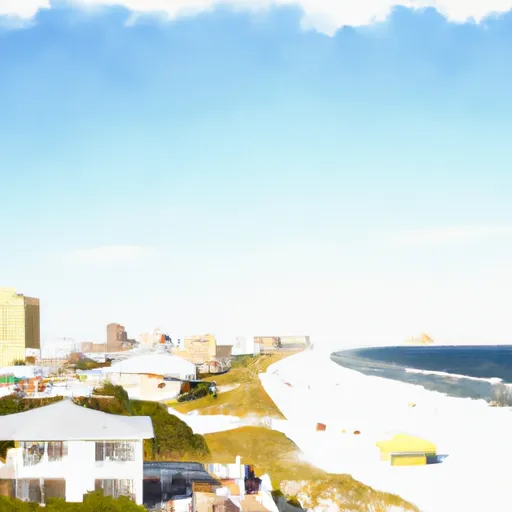-
 Snoflo Premium
Snoflo Premium
Get unlimited access to all our content
With no Ad interruptions! - Start Your Free Trial Login with existing account
Santa-Rosa-Beach
Eden Index
Climate
7.0
•
Recreation
4.8
•
Community
2.2
•
Safeguard
5.0/10

Santa Rosa Beach is located along the scenic coast of Northwest Florida, offering residents and visitors a unique blend of coastal beauty and a laid-back atmosphere. The climate in Santa Rosa Beach is characterized by mild winters and hot summers, with average temperatures ranging from the mid-40s°F in winter to the mid-80s°F in summer. The area enjoys abundant sunshine throughout the year, making it ideal for outdoor activities.
Santa Rosa Beach is surrounded by stunning natural beauty, with the Gulf of Mexico to the south and Choctawhatchee Bay to the north. This provides ample opportunities for various water-based activities, including swimming, fishing, boating, and kayaking. The bay is also known for its diverse ecosystem, attracting birdwatchers and nature enthusiasts.
In terms of hydrology constituents, Santa Rosa Beach boasts pristine white sandy beaches, crystal-clear turquoise waters, and vibrant coastal dune lakes. These rare coastal dune lakes are a unique feature of the area and provide opportunities for paddleboarding, hiking, and wildlife viewing.
With its favorable climate, breathtaking scenery, and abundant outdoor activities, Santa Rosa Beach is a haven for those seeking a coastal paradise to explore and enjoy.
What is the Eden Index?
The Snoflo Eden Index serves as a comprehensive rating system for regions, evaluating their desirability through a holistic assessment of climate health, outdoor recreation opportunities, and natural disaster risk, acknowledging the profound impact of these factors on livability and well-being.
Climate Health Indicator (CHI): 7.0
Santa-Rosa-Beach receives approximately
1646mm of rain per year,
with humidity levels near 89%
and air temperatures averaging around
20°C.
Santa-Rosa-Beach has a plant hardyness factor of
9, meaning
plants and agriculture in this region tend to thrive here all year round.
By considering the ideal temperature range, reliable water supplies, clean air, and stable seasonal rain or snowpacks, the Climate Health Indicator (CHI) underscores the significance of a healthy climate as the foundation for quality living.
A healthy climate is paramount for ensuring a high quality of life and livability in a region, fostering both physical well-being and environmental harmony. This can be characterized by ideal temperatures, reliable access to water supplies, clean air, and consistent seasonal rain or snowpacks.
Weather Forecast
Streamflow Conditions
Florida Panhandle Coastal
Area Rivers
Florida Panhandle Coastal
Snowpack Depths
Florida Panhandle Coastal
Reservoir Storage Capacity
Florida Panhandle Coastal
Groundwater Levels
Recreational Opportunity Index (ROI): 4.8
The Recreational Opportunity Index (ROI) recognizes the value of outdoor recreational options, such as parks, hiking trails, camping sites, and fishing spots, while acknowledging that climate plays a pivotal role in ensuring the comfort and consistency of these experiences.
Access to outdoor recreational opportunities, encompassing activities such as parks, hiking, camping, and fishing, is crucial for overall well-being, and the climate plays a pivotal role in enabling and enhancing these experiences, ensuring that individuals can engage in nature-based activities comfortably and consistently.
Camping Areas
| Campground | Campsites | Reservations | Toilets | Showers | Elevation |
|---|---|---|---|---|---|
| Frank Jackson State Park | 32 | 351 ft | |||
| Fort Toulouse/Jackson Park | 39 | 167 ft | |||
| Topsail Hill Preserve State Park | None | 19 ft | |||
| Florala State Park | 28 | 255 ft | |||
| Maxwell/Gunter AFB Military | None | 164 ft | |||
| Grayton Beach State Park | None | 7 ft |
Nearby Ski Areas
Catastrophe Safeguard Index (CSI):
The Catastrophe Safeguard Index (CSI) recognizes that natural disaster risk, encompassing floods, fires, hurricanes, and tornadoes, can drastically affect safety and the overall appeal of an area.
The level of natural disaster risk in a region significantly affects safety and the overall livability, with climate change amplifying these risks by potentially increasing the frequency and intensity of events like floods, fires, hurricanes, and tornadoes, thereby posing substantial challenges to community resilience and well-being.
Community Resilience Indicator (CRI): 2.2
The Community Resilience Indicator (CRI) recognizes that education, healthcare, and socioeconomics are crucial to the well-being of a region. The CRI acknowledges the profound impact of these elements on residents' overall quality of life. By evaluating educational resources, healthcare accessibility, and economic inclusivity, the index captures the essential aspects that contribute to a thriving community, fostering resident satisfaction, equity, and social cohesion.

